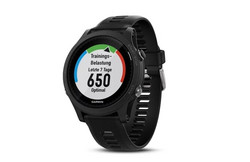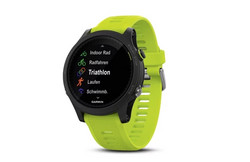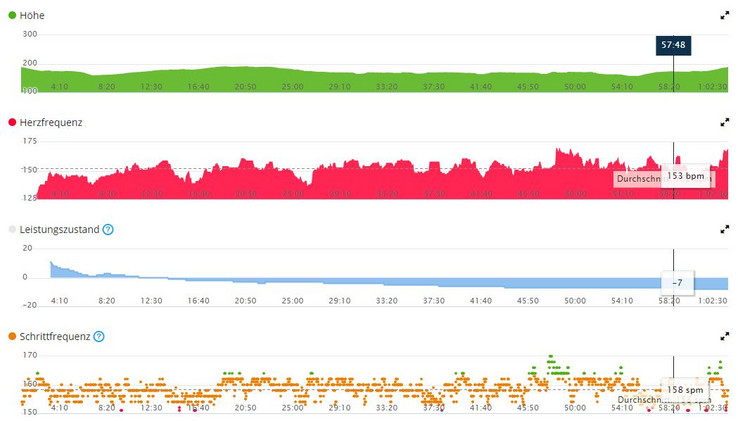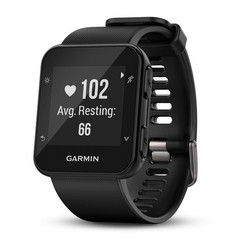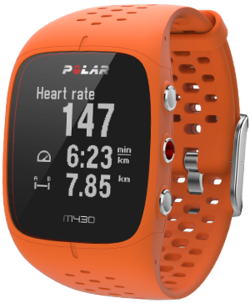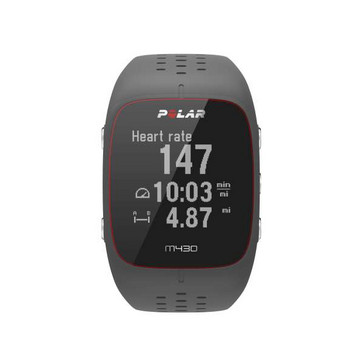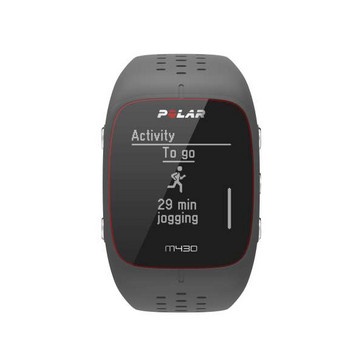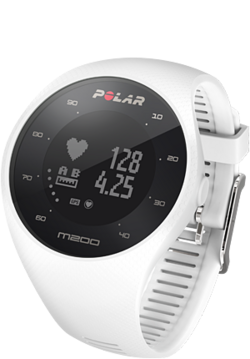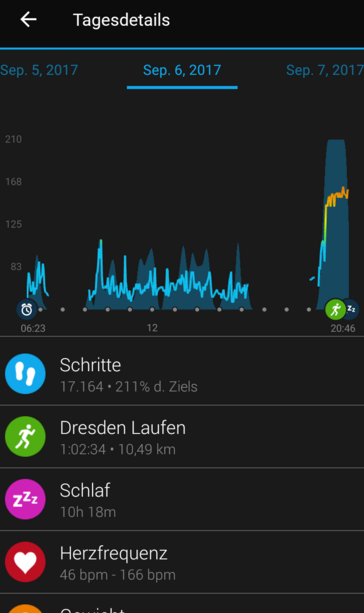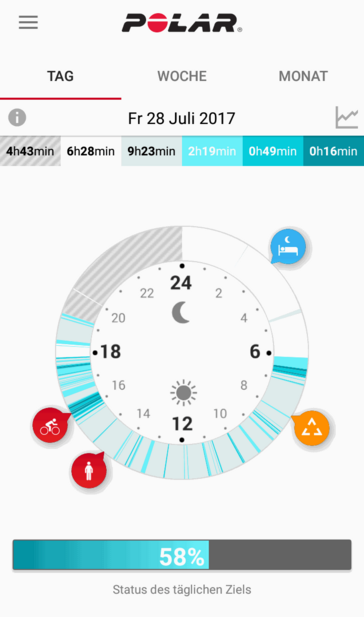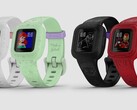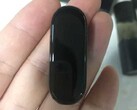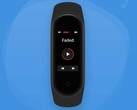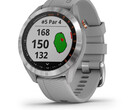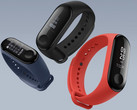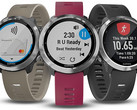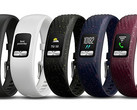Initial Remarks
For the original German article, see here.
First a general remark: Our tests of the sports functions refer almost exclusively to running, since the author is a serious runner and does this regularly, which is even more relevant here. However, you can use all the products tested here for other sports (with some benefit). The quality of the GPS tracking is evaluated by visually comparing the recorded routes. We use a classical track to check the correctness of the distance measurements, and we use a chest strap to evaluate the optical heart rate measurements.
Garmin Forerunner 935
With a listed price of 550 Euros (~$638), the Garmin Forerunner 935 is anything but affordable. However, at least in our opinion the Multisport watch strikes a really good figure. Thanks to its high-quality plastic, the 935 weighs a mere 49 grams (~0.1 lb). Even though the plastic strap does not necessarily make the watch fashionable for a meeting, it provides a secure and comfortable fit. The potential buyer should keep the relatively large diameter of the watch in mind, since the fitness watch would appear quite massive on a delicate wrist. As the only watch of our test comparison, we find the Forerunner 935 completely suitable for everyday life, which is also supported by the many optional watch faces. Although the Forerunner 935 is only available in black, the arm bands are available in several colors.
To simplify, athletes can monitor their fitness all day long with the Forerunner 935, recording and evaluating their individual sports activities with a high accuracy, thanks to GPS and heart rate measurements. During the training session, the watch can optionally provide instructions according to a previously set plan. For example, you can increase the speed in the second third of the run and then later slow it down again, and advanced runners can also program a complex interval-training dependent on the heart rate (the stress range).
The evaluation after the activity is helpful to beginners, particularly in one respect: since the heart rate is measured, you can determine the intensity level (or couch potatoes might say, "difficulty") of the training. With this, you can also determine the rest periods that are necessary, since overambitious beginners in particular tend towards a training intensity that is too high, with the risk of damaging their health or losing their motivation.
The high-contrast display measuring 3.1 cm (~1.2 in) in diameter is useful, particularly during the training: you can easily see the current speed and distance, and during interval training the remaining time of the current interval is also displayed. A small complaint about the latter: the acoustic reminder of the approaching end of the interval is a little weak. However, the vibration is easily noticeable. Furthermore, the display has extensive configuration options.
Basically, the device strikes a good figure during sports activities, and aside from a certain sluggishness, there were no major discrepancies between the optical heart rate measurements and our reference (classical HFR chest strap) during the test. However, when using it for swimming outdoors, the Forerunner is disappointing: In the breast stroke as well as the crawl stroke, 935 points of the route are missing. You can prevent that by either fixing it around a spot that is always above the water (underneath a swimming cap) or by clearly raising it above the water at some points along the way, which is unrealistic and cumbersome. However, in the pool, the Forerunner registers the count of the laps through the directional changes, which works quite well.
By using two keys, you can scroll through the various widgets without any problems. Various information, such as the weather, the heart-rate history, the barometric pressure (including storm warnings), or the number of steps taken is displayed. The navigation concept makes sense, even though it is not that simple - it took us about two days to completely find our way around. In the state of delivery, the classical smartwatch functionality includes the display of notifications and the controls for playing music. With the Maker app, you can also control the smart-home using the watch. There were numerous updates during the first weeks and months after the release, which have improved for example, some minor problems in the heart rate measurements and added new functions, such as the stress level analysis.
The Garmin Forerunner 935 is currently available starting from 530 Euros at Amazon (~$615; $499 in the US).
Garmin Forerunner 35
In the direct comparison to the Forerunner 935, the smaller model in the form of the Forerunner 35 looks much less stylish, but similarly high-quality. At least on paper, the smaller model offers all that even serious runners could expect from a fitness watch, which include GPS location, optical heart rate measurements, and some more.
As with the Forerunner 935, the 35 is designed to be worn all day. It measures the heart rate and steps in everyday life, and analyzes the sleep duration and quality. In practice, with the lack of a digital compass and a barometer, some rather secondary hardware functions are missing. But much more critical is the inability to use the training plans saved in Garmin Connect, which would be quite a useful functionality, particularly for beginners.
Like the larger model, the quite affordable watch, which is currently offered for about 160 Euros (~$185), offers a constant connection to the smartphone for displaying notifications. During the training, the accuracy of the GPS and the heart rate measurement were quite good, and we were unable to observe any major discrepancies compared to the Forerunner 935.
With this, the 35 clearly offers a better price-performance ratio in direct comparison to the Forerunner 935, as long as you only look at the extent of the functions. However, we think the watch is much less suitable for everyday life than the more expensive model. The reason for this is more its square rather than round shape, and not so much that it has only a monochrome, high-contrast display. In everyday life, we like the Forerunner 935 much better, since the watch faces can also be much more individualized.
The Garmin Forerunner 35 is currently available with a choice of four different watch bands for about 160 Euros (~$185; $199 in the US) at Amazon.
Polar M430
The latest model from Polar is called M430 and as with the Forerunner 935, is targeted at serious athletes. There are even six LEDs for the heart rate measurement.
According to Polar, due to the high number of LEDs, aside from the pure heart rate, it is also possible to determine the heart rate variability, which is the change of the time between two heart beats. As long as it is measured accurately, the heart rate variability allows direct conclusions about the physical fitness. For example, you can determine the maximum oxygen uptake in its own mode, which can result in completely unrealistic values "with a little training."
Compared to the Forerunner 935 for example, the M430 looks to us more of a tool dedicated to training than a watch that can really be worn all day. Even though the activity is tracked smartly through the day, the constant monitoring of the heart rate was only possible through a later update. Added to this is a much more "sporty" and pragmatic design, in our opinion. Although this is not negative by itself, it makes the M430 look more like a sports device. The square, but easily readable, monochrome display and the lack of optional watch faces contribute to this impression. The haptic of the watch offers no reason for complaints.
The M430 also works excellently as a sports tracker. The recordings of the GPS position and heart rate are accurate, with the heart rate tracking being slightly more agile than in the Forerunner 935. However, there is no comparison to the chest strap.
The good preparation and evaluation of the training units in particular are very useful. For example, the watch can create individual training plans for beginner runners, taking into account their current fitness levels, while also considering balance training, including the corresponding instructions. With this, we consider the app much more capable than the competitor by Garmin.
The Polar M430 is currently available at Amazon for 192 Euros (~$223; $229 in the US).
Polar M200
TThe affordable Polar M200 is clearly targeted at beginners and combines the two main requirements for a running watch: a GPS sensor and optical heart rate measurement. The optical heart rate measurement works very well, but the sluggishness of the optical measurements, also occurs in the M200. However this is completely irrelevant for beginners. Looking at the map, the GPS recording of the route looks slightly inaccurate in parts, but the distance is correct.
The offered programs for running are extremely valuable, particularly for beginners. As in the other competing models, they can be directly loaded into the watch. It will then monitor the heart rate in particular and warn the runner during the training if the intensity is too high, or provide encouragement to speed up if the heart rate is too low. In addition to the training units, the Polar M200 tracks steps, and as with the other competitors, it also provides warnings if the time of inactivity is too long. As in the rest of the competitors, notifications are also displayed.
The display of the M200 is quite an interesting design. There is only a small square inside the round display, which can actually show symbols freely. A digital bezel allows displaying percentage values, for example. However, we see the biggest weakness of the M200 in the relatively bad haptic, particularly in the armband. The quality itself is good, though.
The Polar M200 is currently available at Amazon starting from 110 Euros (~$128; ~$150 in the US).
Verdict
All four devices that we tested offer accurate recordings of sports activities. Beginners can choose either the Forerunner 35 or Polar M200 without any problems. However, we would recommend the Garmin model because of the better haptic. In our opinion, the M430 by Polar is the clear winner in terms of the price-performance ratio, offering all the necessary functionality even for serious athletes. On the other hand, the Forerunner 935 is the best option for everyday usage with its slightly better choice of materials and the round display in particular. However, it is also 300 Euros (~$348) more expensive and rather a luxury product.





